One of the funnier jokes I’ve heard regarding AI is that it won’t replace developers until clients learn to accurately describe what they want — which is estimated to happen in approximately… never!
And whether you find it funny or not, this joke paints the picture of a real problem in project management and software development.
Clients, product managers, and even customers — they don’t always know exactly what they want, and even when they do, they may not know how to properly communicate that.
Despite this, your job is to make what they want. This is where requirements gathering techniques come into play. With them, you can figure out exactly what it is you’re supposed to build, piece by piece, like building a jigsaw puzzle.
So, here’s everything you need to know about requirements gathering techniques!
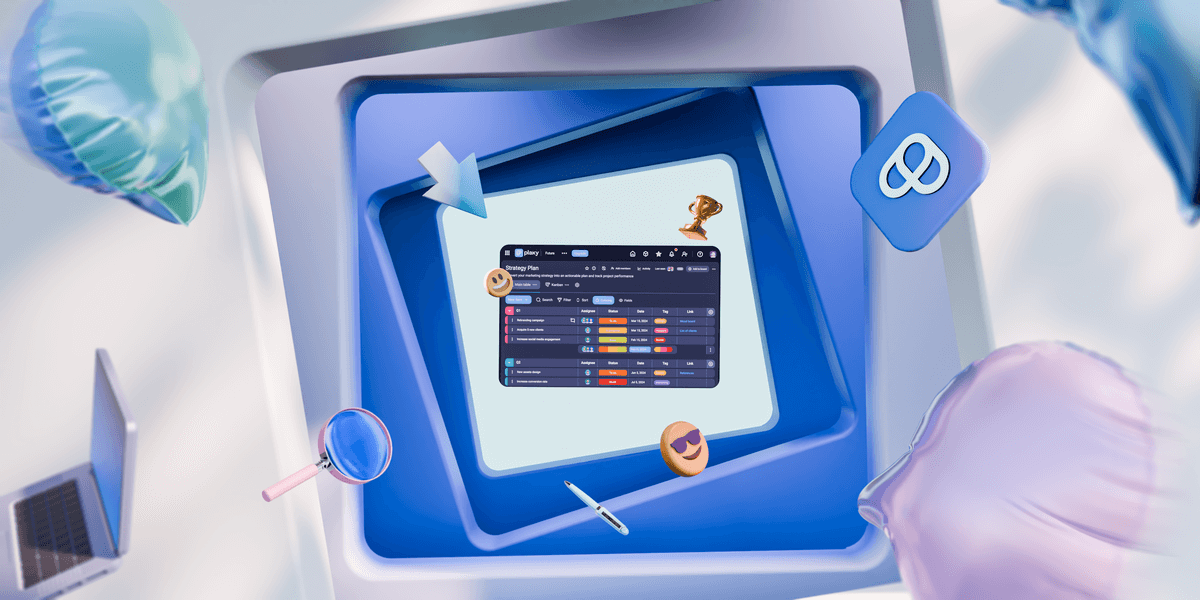
In this article:
What is requirements gathering in project management?
Requirements gathering is the process of identifying, documenting, and managing project objectives and stakeholder needs.
A business requirement is a description of the condition the final product or service needs to be in to satisfy a business need.
In other words, requirements outline exactly what the features of your product or service need to do and which functions they need to fulfill.
We can distinguish between 2 general types of requirements that every project has:
- Business requirements — define what the organization wants or needs to be able to do once the project is completed, and
- Technical requirements — define solutions for how each project need will be satisfied.
All in all, requirements outline what you need to accomplish to complete a project successfully.
💡 Plaky Pro Tip
Learn how to write a business requirements document (BRD) — an outline of your project’s business objectives — in the guide below:
Top 15 requirements gathering techniques
Collecting requirements is the first step in creating a project scope management plan — which makes it one of the most important steps toward a successful project.
However, requirements are a tricky thing — they can stay hidden, get misunderstood, or just change over time.
And that’s assuming that stakeholders know exactly what they want, which isn’t always the case. Eliciting requirements from stakeholders is often difficult precisely because they’re vague and undefined.
And we know this is an issue because 70% of failed projects go downhill due to poor requirements and up to 50% of project rework is a result of requirements problems.
So, since you can’t build a strong foundation for your project without clear requirements, we’ve compiled this list of the 15 best requirements gathering techniques:
- Interviews,
- Focus groups,
- Facilitated workshops,
- Questionnaires or surveys,
- Brainstorming,
- Mind mapping,
- Role-play,
- Observations,
- Document analysis,
- Reverse engineering,
- Prototyping,
- Benchmarking,
- Context diagrams,
- Use cases and scenarios, and
- Interface analysis.
Try them out and see what works for your projects and your stakeholders.
Gather project requirements in Plaky
Technique #1: Interviews
During an interview, your goal is to elicit information about project requirements by directly talking to stakeholders.
Ask them questions about the project and take notes. Spontaneous questions are okay — some are bound to come up during the dialogue — but make sure to prepare the most important questions ahead of time.
Being prepared for the interview increases your chances of gathering the necessary information.
Of course, stakeholders should have a general idea of what the conversation will look like in advance. Knowing what topics you plan to cover in the meeting will give them a chance to prepare and offer clearer answers during the interview.
Here are some more useful interview tips to keep in mind:
- Start the interview by asking general questions — This allows stakeholders to describe what they need, in their own words, and give you insight into their goals and expectations.
- Avoid asking open-ended questions that can be answered with short answers — You want to gather specific information, and “Yes” or “No” answers simply won’t provide relevant data.
- Restate what you hear — This is a good way of reaffirming what the stakeholders want, as it reduces the chances of a misunderstanding. For example, a restatement such as: “This is important to you because it makes your business more secure?”, allows a project manager to confirm to what degree the security issue is important to a particular stakeholder.
- Ask a lot of follow-up questions — It enables eliciting all the specifics.
- Always listen carefully — Having good listening skills and establishing a good rapport with stakeholders is key to truly understanding their needs.
Technique #2: Focus groups
Focus groups are small group interviews that include a moderator and stakeholders, all engaged in an interactive discussion to elicit or refine the necessary project requirements.
Compared to 1-on-1 interviews, focus groups are designed to be more conversational.
Technique #3: Facilitated workshops
Similarly to focus groups, facilitated workshops are focused sessions that bring key stakeholders together to define product requirements.
However, workshops are much more:
- Collaborative,
- Creative, and
- Action-oriented.
Workshop participants usually work together in teams — they engage in different activities to create solutions to a certain problem.
This is a go-to technique for working out stakeholder differences and defining cross-functional requirements.
Furthermore, because of their interactive nature, workshops:
- Build trust,
- Foster relationships, and
- Improve communication among participants.
Here are 2 specific examples of facilitated workshops in different industries:
- Joint Application Development (JAD)
- Quality Function Deployment (QFD)
Joint Application Development (JAD)
Joint Application Development/design sessions are a technique used specifically in the software development industry.
The goal of JAD workshops is to bring together subject matter experts and the development team to improve the software development process and clarify the requirements.
💡 Plaky Pro Tip
Once you’ve got the requirements down for your software development project, you should create a solid plan for how to execute the project. If you’re not sure how to do this or you haven’t done it before, this guide should help you out:
Quality Function Deployment (QFD)
This is a technique used in the manufacturing industry.
The goal of the Quality Function Deployment (QFD) workshop is to determine critical characteristics for new product development.
Among other things, during a requirements workshop, participants develop so-called user stories — i.e., short textual descriptions of required functionalities, widely used in Agile.
Technique #4: Questionnaires or surveys
Questionnaires or surveys are a great replacement for interviews when you’re pressed on time or dealing with several stakeholders, especially when these stakeholders are working across different time zones.
They’re ideal in situations where you have to process a large amount of data, as the info you collect through surveys and questionnaires is easy to analyze and interpret.
Just be mindful of how you frame questions, as different framings can result in different outcomes.
Technique #5: Brainstorming
Brainstorming is a technique used to come up with multiple ideas related to project requirements. It’s a group creativity technique that serves as a great starting point for your requirements gathering process.
Using a simple tool, such as a whiteboard, you can quickly start brainstorming all the ideas that pop into your mind — and then write them down.
At this point, the more ideas you generate — the better.
After the brainstorming session has ended, you will take time to analyze the ideas in more detail, focusing on the good ones.

Technique #6: Mind mapping
Mind mapping is a creative technique used to visually organize your ideas.
Mind maps (or idea maps, it’s the same thing) work great with brainstorming. You can categorize all the previously brainstormed ideas (i.e., requirements) into different groups and see how these groups interact and relate to each other visually.
Having all the ideas transparently displayed in front of you will facilitate further idea generation.
Technique #7: Role-play
The role-play technique is excellent for discovering the viewpoints of diverse users and generating new ideas.
During role-play, different people take on the roles of different user types.
This interactive approach helps you understand various user perspectives and their individual product requirements and needs.
Technique #8: Observations
Observation is the action of monitoring somebody or something in order to gather information.
It may sound a bit sneaky, but it’s not. And in cases where observation is required, no other technique will work.
This happens when users can’t articulate requirements because they’re not even aware of them. In that case, you can use observation to uncover these hidden requirements.
Seeing users in their natural environment and observing how they use a product, or what difficulties they might face allows you to identify precisely what the users need.
Technique #9: Document analysis
Document analysis is the process of defining requirements by analyzing existing documentation and identifying relevant information.
It’s a boring and strenuous job, but it is another avenue for requirements gathering. Here’s a list of documents that you can analyze:
- Business plans,
- Marketing literature,
- Agreements,
- Requests for proposal,
- Current process flows,
- Logical data models,
- Business rules,
- Repositories,
- Application software documentation,
- Business process or interface documentation,
- Use cases,
- Other requirements documentation,
- Problem/issue logs,
- Policies,
- Procedures, and
- Regulatory documentation (e.g., laws, codes, ordinances, etc.).
Technique #10: Reverse engineering
Reverse engineering is the process of deconstructing an existing system to learn how it is built.
It’s like taking a toy apart to learn how it works. By understanding how something works, you can develop a comprehensive list of functional requirements.
After you have gained knowledge about the subject in question, you can then duplicate it or enhance it.
You can apply reverse engineering to many things, including software and physical machines.
Technique #11: Prototyping
Prototyping is a technique for obtaining early feedback on requirements by building a working model of the expected product.
Basically, it’s a mock-up of the final product that you can experiment with.
Though they can be pretty costly, prototypes are useful for 3 reasons:
- They allow users to try out a product’s mock-up versions before the final product release.
- They are excellent for feedback generation.
- Based on the prototype performance, you can make necessary adjustments.
Various modern prototyping tools facilitate making mock-ups — they are particularly useful for agile and other software development projects.
Technique #12: Benchmarking
In simple terms, benchmarking is the performance comparison of your company’s product with the competitor’s product that’s considered to be the best in the industry.
Benchmarking is a great requirements gathering technique, as it allows you to:
- Identify the best practices,
- Generate ideas for improvement, and
- Provide a basis for measuring performance.
Technique #13: Context diagrams
A context diagram is a visual requirements gathering technique.
As the name suggests, these diagrams are used for presenting the entire context of the process.
They depict a business system (e.g., a process, equipment, a computer system, etc.), and how people and other systems interact with it.
Technique #14: Use cases and scenarios
Use cases are an excellent technique for collecting specific requirements in various situations. By exploring different scenarios, you can learn which feature or functionality should be used in which specific case.
Use cases are expressed in step-by-step lists of tasks that should be performed to accomplish business objectives.
On the other hand, scenarios — also known as user stories — are short textual descriptions of required functionalities, in the form of a narrative.
User stories describe:
- The stakeholder who benefits from the feature (i.e., the role of each stakeholder in the product development process),
- What the stakeholder needs to accomplish (i.e., the goal of each stakeholder), and
- The benefit to the stakeholder (i.e., the motivation that drives stakeholders to develop specific features).
User stories are typically formatted in the following way: As a [persona], I [want to], [so that].
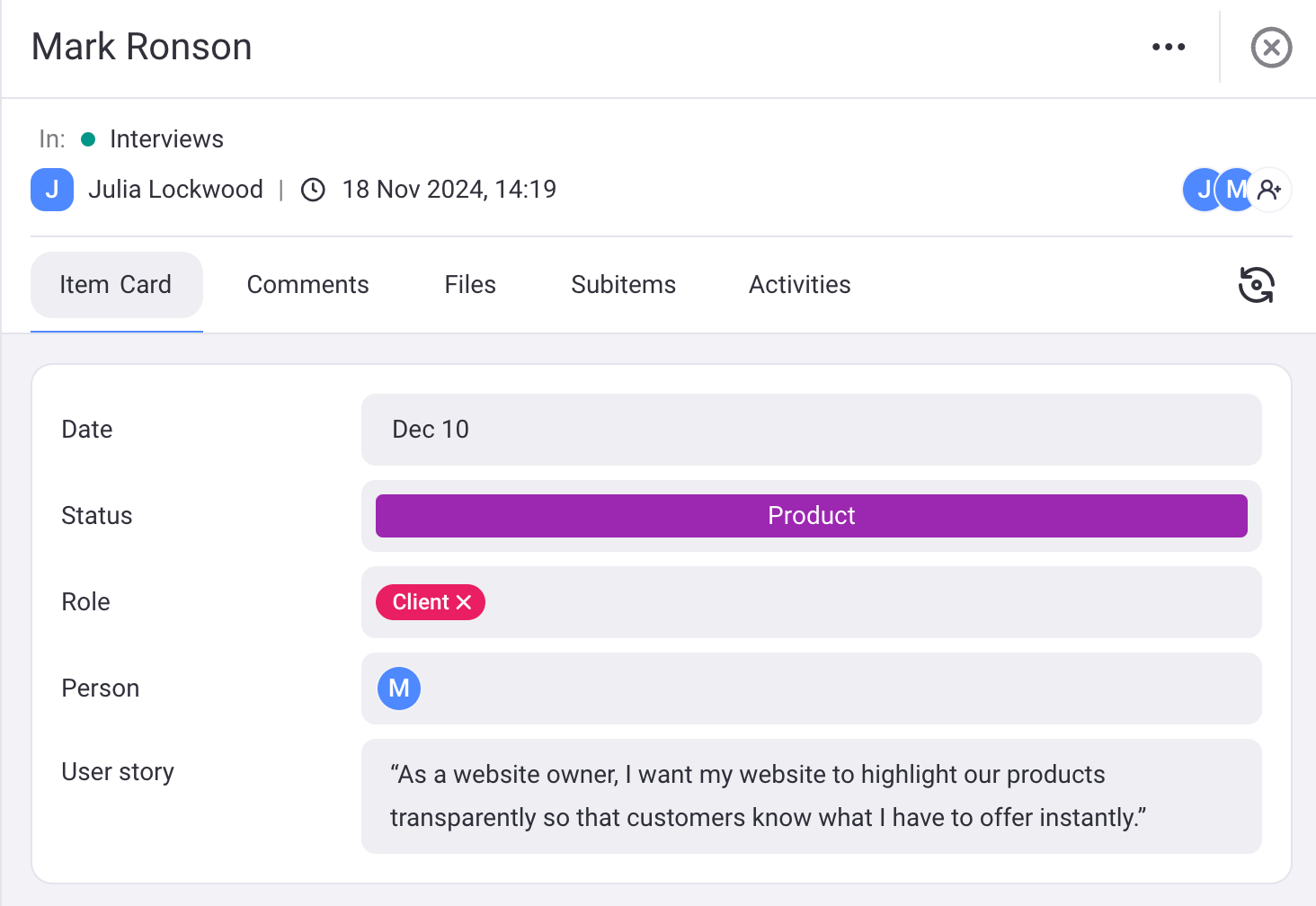
Technique #15: Interface analysis
Interface analysis is a technique that helps you understand how your system works.
In this case, interface doesn’t only refer to UI. Instead, it refers to all interactions between your system and anything else that interacts with it. Yes, this includes people, but it also includes peripherals (mouse, keyboard, touch screen, etc.), hardware, APIs, external systems, and so on.
By conducting interface analysis, you can discover unexpected requirements that no single stakeholder would otherwise be aware of.

The requirements gathering process in 6 steps
While the focus of this guide is on requirements gathering techniques, I’d still like to quickly walk you through the 6-step requirements gathering process, which includes:
- Identifying stakeholders,
- Meeting with key stakeholders,
- Identifying and documenting requirements,
- Creating a requirements management plan,
- Getting the plan approved, and
- Monitoring requirements.
Step 1: Identify the stakeholders
All the techniques I’ve listed can help you elicit requirements from stakeholders, but step 1 is to first figure out who these stakeholders are.
Some stakeholders are obvious — the client, for example.
But the term stakeholder actually refers to anyone invested in the project. In addition to clients, this includes team members, higher-ups in your organization, external vendors, customers, etc.
Once you have the list of stakeholders down, you can decide which people should help you identify requirements and how.
Obviously, clients need to explain what exactly it is they want. However, developers can provide insight into how feasible this is and which steps you’d need to take to complete the project.
Step 2: Meet with the key stakeholders
Step 2 entails meeting and interviewing key stakeholders. By key stakeholders, I mean the people that you’re running this project for — typically clients and higher management.
The goal of these interviews is to get more insight into what they want out of the project.
For now, ask them big-picture questions, like:
- What their goals and concerns are regarding the project,
- Why they think it will be successful, and
- How they think they’ll stand out from the competition.
Step 3: Identify and document the requirements
Step 3 is pretty much what this entire blog post was about — utilizing various techniques to elicit requirements from stakeholders.
Use the techniques best suited to your project to find out exactly what it is you need to make and how you need to make it.
This is also where you can work with stakeholders and subject matter experts to prioritize certain requirements over others to make project execution more feasible.
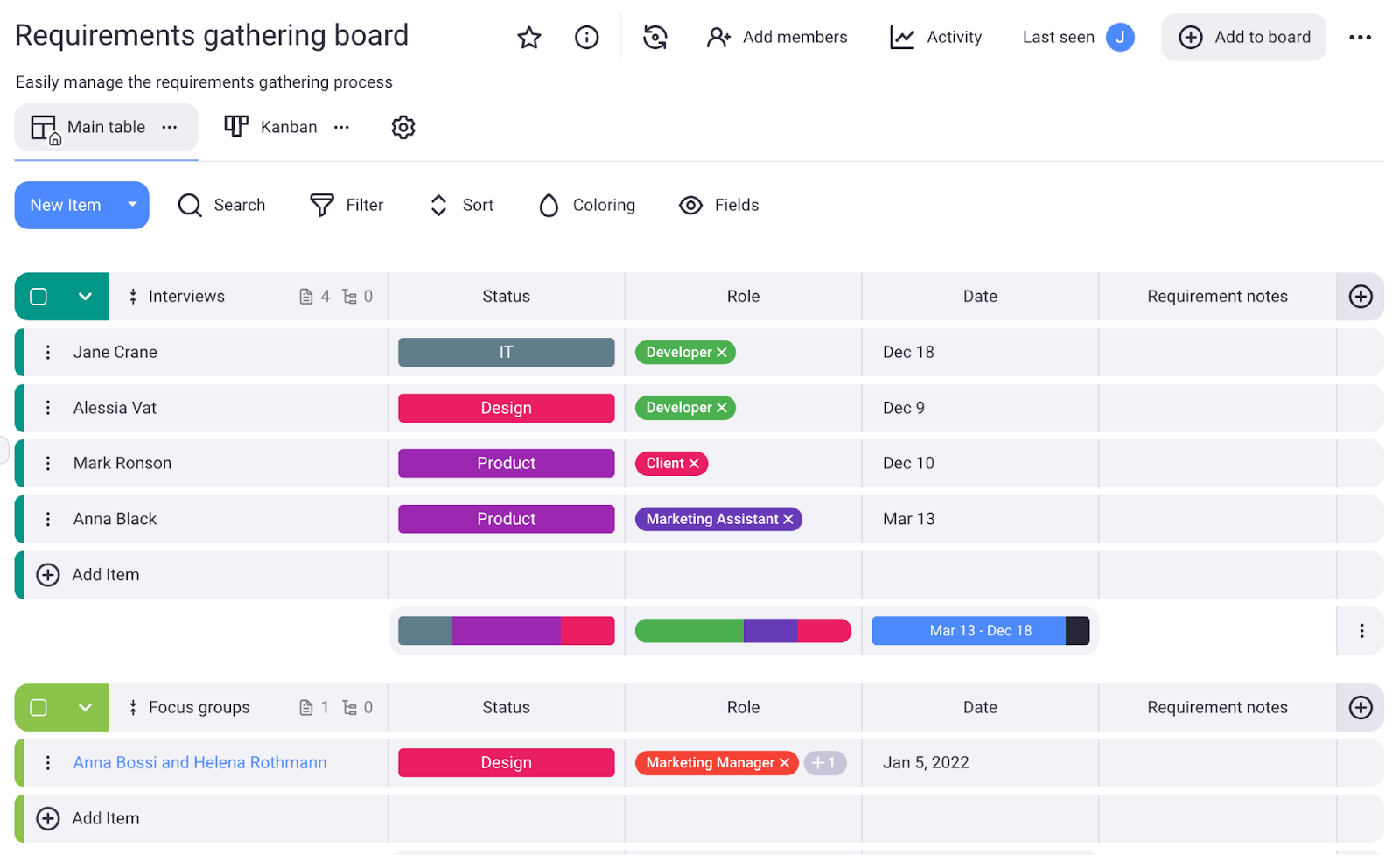
Step 4: Create a requirements management plan
Once you’ve gathered all the requirements, you should use them to make a plan.
There’s a lot that goes into creating a detailed requirement management plan, but the big picture elements include figuring out the:
- Project timeline — how long the project will take to complete, ideally with laid out milestones to help measure progress.
- People involved — includes the project team, as well as other stakeholders, like vendors, clients, project sponsors, etc.
- Project risk management plan — a list of positive and negative risks that the projects may encounter as well as response strategies for each project risk.
This part is super-important, so make sure you’re using the right planning tools.
A great option is to use a project management tool where you can easily keep track of all changes in real time and ensure no detail gets missed.
Such a tool should also enable you to transparently share your requirements management plan with all involved parties and guarantee everyone’s on the same page.
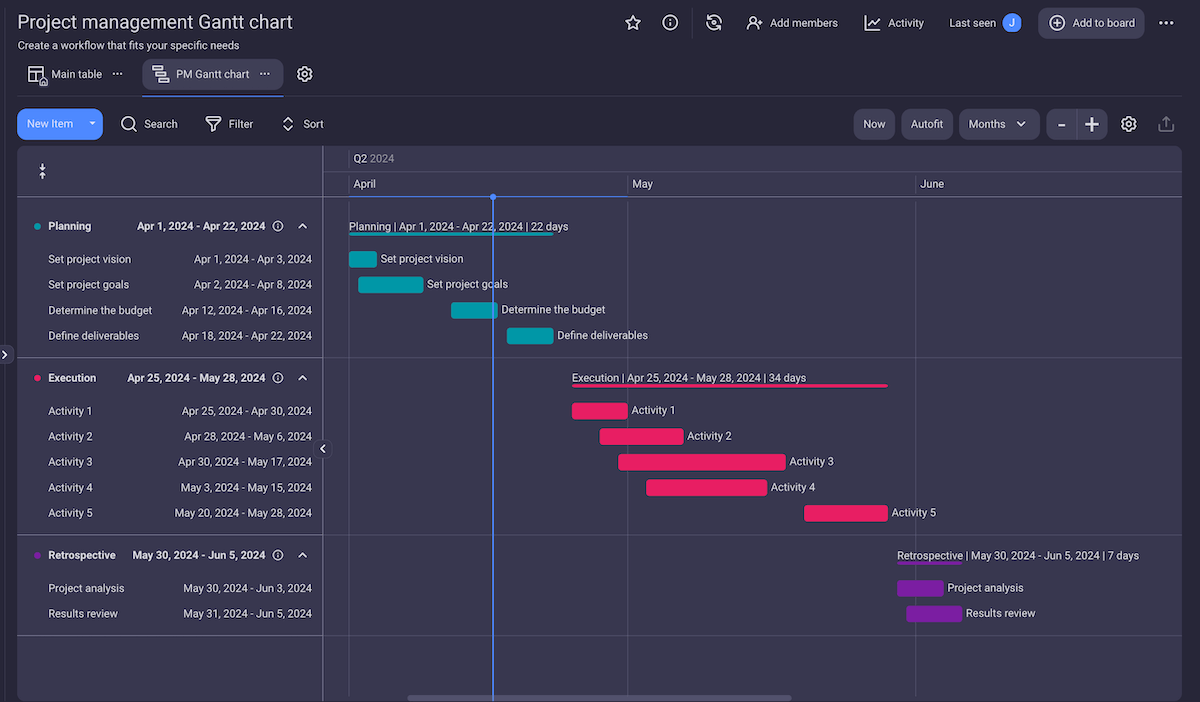
Step 5: Get the plan approved
When you’re satisfied with the plan, present it to your stakeholders to get their approval.
Obviously, you have to get the client to sign off on it before you can start working on the project, but getting other stakeholders’ approval is also invaluable.
For example, developers can notify you of any unrealistic time estimates in your project schedule.
Step 6: Monitor the requirements
Last but not least, monitor the progress of your project. Check whether the execution is within the boundaries of the project scope. Monitor risks. Track the budget.
Basically, just do everything you normally do while managing projects, knowing that the entire process rests on a firm foundation.
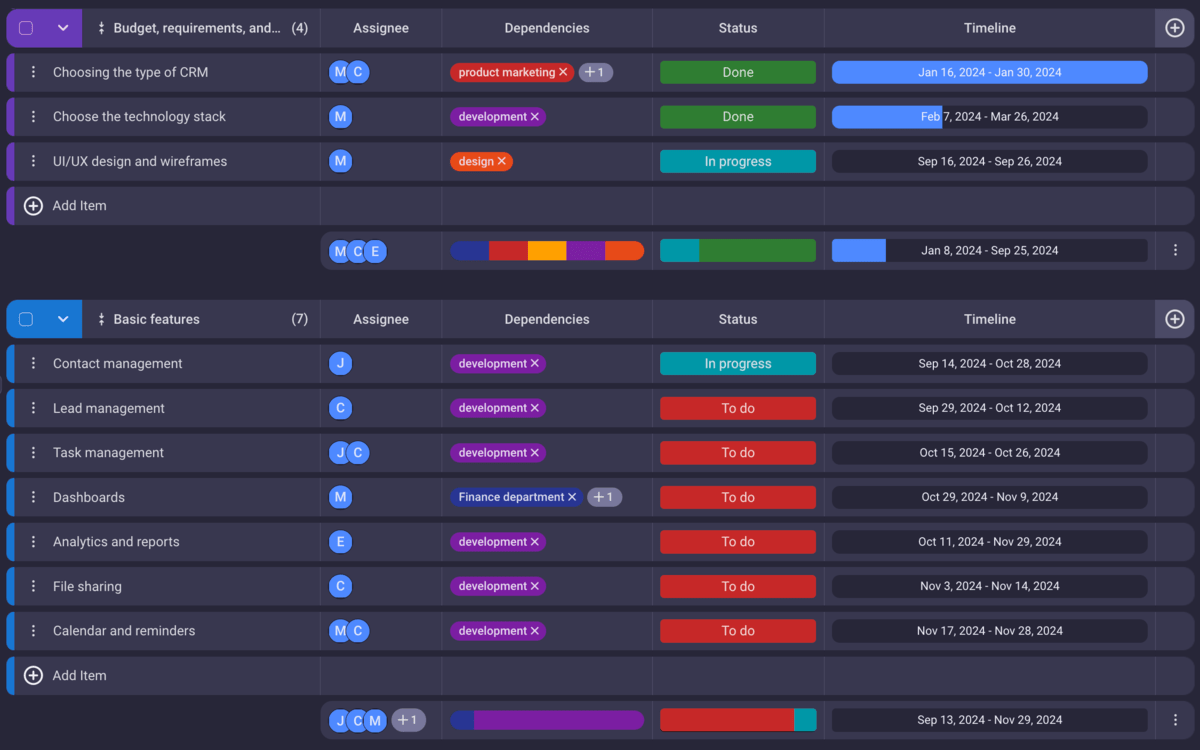
Manage requirements and tasks in Plaky
As already stated, 70% of project failures happen because of poor requirements, so conducting thorough requirements gathering should be a mandatory step in managing all projects.
The best way to do this is by using software that can support your requirements gathering efforts from the word go.
A perfect example of such software is Plaky, as it allows you to:
- Make a customized board for requirements gathering,
- Make a separate item for every requirement,
- Assign stakeholders to relevant requirements,
- Keep track of interviews using the date field,
- Communicate within items using the comments to keep discussions laser-focused on specific requirements, and
- Upload files and share links to pinpoint key elements for specific requirements.
All you have to do is pick the right technique for each requirement.
Once you’re done, that board can act as a requirement repository that all team members can access for reference. And thanks to powerful filtering and sorting features, finding specific requirements should be a breeze, even if the list is comprehensive.
Using Plaky this way will increase transparency within your project team and keep all stakeholders on the same page.
Even better, Plaky is a bonafide project management tool that your entire team can keep using throughout the entire project to manage:
- Tasks,
- Schedules,
- Risks, and more.
This allows it to act as a centralized information hub for all project-related communication and activity.
Manage requirements and tasks in Plaky to facilitate project success. Sign up now and start your 14-day free trial.

